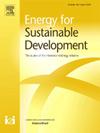Electricity consumption and its determinants in rural Mozambique – At the edge of the electricity grid
IF 4.4
2区 工程技术
Q2 ENERGY & FUELS
引用次数: 0
Abstract
The lack of reliable data on electricity consumption is one of the main obstacles to selecting the right supply technologies and allocating resources to achieve universal electricity access in sub-Saharan Africa. Using data collected from on-site surveys, this study aims to estimate electricity consumption in rural Mozambique at the edge of the electricity grid and examine the factors that influence it. The consumption is estimated for households, community institutions, and productive users in four different localities. Three of the localities are off-grid and rely largely on Solar Home Systems, while one is a small town and has access to grid electricity. To analyze the determinants of electricity consumption, multiple linear regression models are used. The results show that households account for >62 % of the total electricity consumption. The average household consumption in the grid-electrified town (2.54 kWh/day) is significantly higher than in the off-grid localities (0.04 to 0.24 kWh/day). Furthermore, the load profiles of households in the grid-electrified town and off-grid localities differ significantly. However, productive users consume the most electricity per user in all localities. The regression analysis shows a positive and strong relationship between consumption and appliance ownership, with refrigerators and televisions having the most significant influence in the grid-powered locality, and cellphones and LED lamps having the biggest effect in the off-grid areas. The study demonstrates the substantial spatial and sectoral differences in electricity consumption in rural Mozambique. It also reveals how access to grid electricity, productive use, and appliance ownership shape electricity consumption in rural Mozambique. Understanding these dynamics is thus crucial for accurate demand forecasting and optimal rural electrification planning.
莫桑比克农村的电力消耗及其决定因素——处于电网边缘
缺乏可靠的电力消耗数据是撒哈拉以南非洲选择正确的供电技术和分配资源以实现普遍通电的主要障碍之一。利用从现场调查收集的数据,本研究旨在估计莫桑比克农村电网边缘地区的用电量,并检查影响用电量的因素。对四个不同地区的家庭、社区机构和生产用户的消费量进行了估计。其中三个地区离网,主要依赖太阳能家庭系统,而一个是小城镇,可以接入电网。为了分析电力消费的决定因素,使用了多元线性回归模型。结果表明,家庭用电量占总用电量的62%。并网城镇家庭平均用电量(2.54千瓦时/天)显著高于离网地区(0.04 ~ 0.24千瓦时/天)。此外,并网城镇和离网地区的家庭负荷分布也存在显著差异。然而,在所有地区,生产性用户的人均用电量最多。回归分析显示,消费与家电拥有量之间存在很强的正相关关系,电冰箱和电视对并网地区的影响最大,而手机和LED灯对离网地区的影响最大。该研究表明,莫桑比克农村电力消费存在巨大的空间和部门差异。报告还揭示了电网供电、生产用电和电器拥有率如何影响莫桑比克农村的用电量。因此,了解这些动态对于准确的需求预测和优化农村电气化规划至关重要。
本文章由计算机程序翻译,如有差异,请以英文原文为准。
求助全文
约1分钟内获得全文
求助全文
来源期刊

Energy for Sustainable Development
ENERGY & FUELS-ENERGY & FUELS
CiteScore
8.10
自引率
9.10%
发文量
187
审稿时长
6-12 weeks
期刊介绍:
Published on behalf of the International Energy Initiative, Energy for Sustainable Development is the journal for decision makers, managers, consultants, policy makers, planners and researchers in both government and non-government organizations. It publishes original research and reviews about energy in developing countries, sustainable development, energy resources, technologies, policies and interactions.
 求助内容:
求助内容: 应助结果提醒方式:
应助结果提醒方式:


